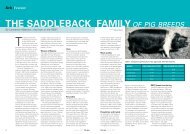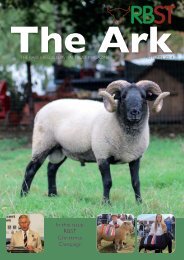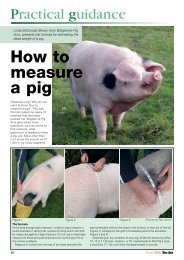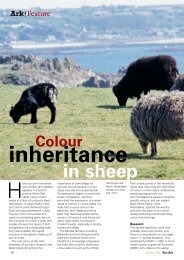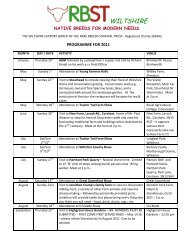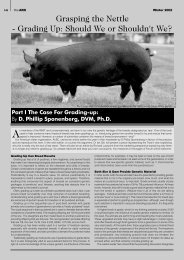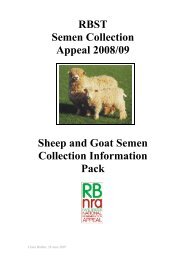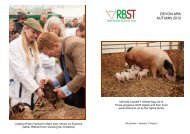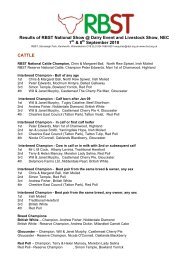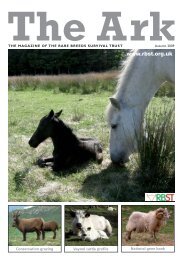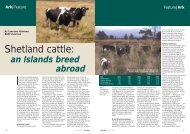Response of RBST - Rare Breeds Survival Trust
Response of RBST - Rare Breeds Survival Trust
Response of RBST - Rare Breeds Survival Trust
You also want an ePaper? Increase the reach of your titles
YUMPU automatically turns print PDFs into web optimized ePapers that Google loves.
Consultation on the implementation <strong>of</strong><br />
Electronic Identification for Sheep<br />
and<br />
individual recording for Sheep and Goats<br />
<strong>Response</strong> <strong>of</strong> <strong>RBST</strong><br />
<strong>Rare</strong> <strong>Breeds</strong> <strong>Survival</strong> <strong>Trust</strong>, Stoneleigh Park, Nr. Kenilworth. Warwickshire CV8 2LG<br />
Tel: 024 7669 6551 Fax: 024 7669 6706 e-mail enquires@rbst.org.uk website www.rbst.org.uk<br />
Patron: His Royal Highness The Prince <strong>of</strong> Wales KG KT GCB<br />
Registered Charity No. 269442. Company Limited by Guarantee Registered in England No. 1204694
The <strong>Rare</strong> <strong>Breeds</strong> <strong>Survival</strong> <strong>Trust</strong> (<strong>RBST</strong>) is the Non-Governmental Organisation dedicated to the<br />
conservation <strong>of</strong> native Farm Animal Genetic Resources, with particular responsibility for native<br />
breeds at risk. It also is the breed society for eight breeds <strong>of</strong> sheep registered in the Combined<br />
Flock Book (Boreray, Castlemilk Moorit, Manx Loaghtan, Norfolk Horn, North Ronaldsay, Portland,<br />
Soay, Whitefaced Woodland). It has supported native breeds at risk since its foundation in 1973,<br />
and has highlighted the negative impact <strong>of</strong> increasing bureaucracy and regulation on the sheep<br />
industry in the UK. The <strong>Trust</strong> has around 10,000 members throughout the United Kingdom and a<br />
very flourishing support group network.<br />
<strong>RBST</strong> Opposed to Electronic Identification (EID)<br />
<strong>RBST</strong> is opposed to the introduction <strong>of</strong> EID in sheep because its investigations show that the<br />
additional costs and regulation will severely reduce the number <strong>of</strong> keepers <strong>of</strong> native breeds at risk<br />
and hence further endanger those breeds. These breeders already keep detailed and accurate<br />
records <strong>of</strong> their pedigree sheep. A survey carried out by <strong>RBST</strong> in 2008 indicated that 32% <strong>of</strong><br />
owners <strong>of</strong> sheep breeds at risk intended to cease keeping such stock within three years specifically<br />
as a result <strong>of</strong> the introduction <strong>of</strong> EID. This outcome is reinforced by the statement in the Executive<br />
Summary (5.1.7.) <strong>of</strong> the Impact Assessment (Defra) version 1 (12 March 2009) that the “estimated<br />
tipping points at which manual recording is not viable or economical and a keeper would chose to<br />
record manually is 200 breeding ewes for option 1 - -.” These producers would still incur the extra<br />
costs <strong>of</strong> electronic tagging. Therefore, introduction <strong>of</strong> EID is contrary to the UK’s commitment to the<br />
conservation <strong>of</strong> farm animal genetic resources under the Convention on Biological Diversity, and to<br />
the objectives <strong>of</strong> Council Regulation (EC) 870/2004 (“- - to conserving genetic resources and<br />
increasing the use <strong>of</strong> under-utilised breeds and varieties in agricultural production”).<br />
<strong>RBST</strong> notes that the partial impact assessments carried out by Defra in relation to the introduction<br />
<strong>of</strong> EID did not consider the impacts on breeds at risk and requests that an assessment <strong>of</strong> the<br />
impact EID will have on the UK’s farm animal genetic resources be conducted prior to<br />
implementation.<br />
<strong>RBST</strong> notes that the proposals for implementation apply only to England. It is essential that there is<br />
consistent application throughout the UK otherwise the ability to trade within the UK will be<br />
compromised.<br />
<strong>RBST</strong> notes clause 11 <strong>of</strong> EC Regulation 21/2004 which states: “In Member States with a relatively<br />
small ovine or caprine animal population, the introduction <strong>of</strong> an electronic identification system may<br />
well not be justified; it is therefore advisable to allow such Member States to make the system<br />
optional.” This derogation indicates that electronic identification is not essential to achieve the<br />
objectives in the EU, and <strong>RBST</strong> requests that the derogation is extended to native breeds at<br />
risk in the UK.<br />
In the context <strong>of</strong> the specific questions posed in the consultation, and without prejudice to the items<br />
above, <strong>RBST</strong> responds as follows:<br />
Question 1.<br />
Do you agree that Defra should implement the slaughter derogation to its fullest extent, which is<br />
the least burdensome and lowest cost option overall. If you do not agree please explain why and<br />
identify your preferred option.<br />
<strong>Response</strong>:<br />
<strong>RBST</strong> does not consider any <strong>of</strong> the options are acceptable, but would agree that Option 1<br />
presents the least problems to breeders and primary producers. However, it must be noted<br />
that Option 1 will cause greater problems for finishing units and auction marts, and this will<br />
have a knock-on detrimental effect throughout the industry. “Store lamb finishers may<br />
choose to purchase only lambs that have been electronically identified” and thus producers<br />
may have no option in practice.
Question 2.<br />
Do you agree that the slaughter tag should not include an individual number because <strong>of</strong> the<br />
increased recording burden this would impose on keepers throughout the chain<br />
<strong>Response</strong>:<br />
<strong>RBST</strong> agrees, provided that this does not prohibit the inclusion <strong>of</strong> an individual number for<br />
the owner’s purposes, and in the awareness that store lamb finishers may choose to<br />
purchase only lambs that have been electronically identified (see above).<br />
Question 3.<br />
Do you agree that we maintain the use <strong>of</strong> the slaughter derogation for goats unaltered<br />
<strong>Response</strong>:<br />
<strong>RBST</strong> agrees.<br />
Question 4.<br />
Do you agree the proposed simplified replacement rules If not please explain why and what your<br />
proposals are.<br />
<strong>Response</strong>:<br />
<strong>RBST</strong> agrees, but notes that owners <strong>of</strong> pedigree sheep are likely to prefer the identical<br />
numbered replacement tags which will further increase costs.<br />
Question 5.<br />
Do you agree that we should not require cross referencing where different numbered replacements<br />
are applied on the holding <strong>of</strong> birth in respect <strong>of</strong> animals born before 31 December 2009 only Or<br />
would you prefer to see replacements cross referenced as for animals born or identified after 31<br />
December 2009 so that the rules are the same<br />
<strong>Response</strong>:<br />
The proposed revisions are not significant, but greater consistency would be achieved if all<br />
replacements are cross-referenced. The over-riding problem for some breeds is that small<br />
ears limit the number <strong>of</strong> times replacement tags that can be inserted (see notes at the end<br />
<strong>of</strong> this response on equipment).<br />
Question 6.<br />
Do you agree that metal tags should not be removed because <strong>of</strong> potential welfare issues<br />
<strong>Response</strong>:<br />
<strong>RBST</strong> agrees.<br />
Question 7.<br />
Do you agree that the use <strong>of</strong> injectable transponders should not be authorised until such time as<br />
public health issues have been addressed<br />
<strong>Response</strong>:<br />
<strong>RBST</strong> agrees.<br />
Question 8.<br />
Do you agree that where a bolus is applied the match up non electronic ear tag should be black<br />
with distinguishable letters and numbers<br />
<strong>Response</strong>:<br />
<strong>RBST</strong> considers that the significant loss (e.g. regurgitation) <strong>of</strong> boluses experienced in<br />
previous projects (e.g. National Scrapie Plan (NSP)) renders them an unreliable and hence<br />
ineffective method <strong>of</strong> identification for traceability. The use <strong>of</strong> boluses would require flock<br />
owners (whatever the flock size) to have constant access to a reader to ascertain whether a<br />
bolus was present. <strong>RBST</strong> recommends that boluses are not used for EID.<br />
Question 9.<br />
Do you agree that all electronic tags should be yellow in colour to ensure that electronic tags are<br />
distinguishable from non-electronic ones If not please explain why and <strong>of</strong>fer an alternative<br />
solution.
<strong>Response</strong>:<br />
Ear tags are supplied in pairs by the manufacturers and alternate colours within a batch <strong>of</strong><br />
tags are not possible. <strong>RBST</strong> disagrees with this requirement.<br />
Question 10.<br />
Do you agree that we should only authorise the use <strong>of</strong> electronic identifiers and reading equipment<br />
which conform to the minimum requirements and the Technical Guidelines<br />
<strong>Response</strong>:<br />
<strong>RBST</strong> agrees, but with the proviso that all EID tags and readers should be compatible,<br />
otherwise the tags on purchased animals may not be readable by the purchasers (also see<br />
notes below).<br />
Question 11.<br />
Do you agree that contingency arrangements should be put in place to ensure that normal trading<br />
practices are not disrupted in the event <strong>of</strong> power or equipment failure If so what do you think<br />
these arrangements might be<br />
<strong>Response</strong>:<br />
<strong>RBST</strong> agrees with the arrangements as outlined in the consultation document.<br />
Question 12.<br />
Do you have any suggestions about how we could further reduce costs and burdens<br />
<strong>Response</strong>:<br />
<strong>RBST</strong> is particularly concerned about the impact <strong>of</strong> EID on breeds at risk, which are <strong>of</strong>ten<br />
kept in small flocks for which the additional costs are disproportionate. However, most<br />
keepers <strong>of</strong> breeds at risk are adept at pedigree recording and well used to keeping<br />
individual records. <strong>RBST</strong> urges that a derogation for breeds at risk is made to the effect that<br />
the current double ear tagging, plus a requirement for individual recording, is available for<br />
keepers <strong>of</strong> breeds at risk. This would encourage both new keepers <strong>of</strong> breeds at risk and<br />
support existing keepers, and hence contribute to the conservation <strong>of</strong> the U.K.’s farm<br />
animal genetic resources.<br />
Other comments:<br />
Impact assessment:<br />
<strong>RBST</strong> requests that an assessment <strong>of</strong> the impact EID will have on the UK’s farm animal genetic<br />
resources be conducted prior to implementation.<br />
Website:<br />
Paragraph 4.32 is unclear in stating that the ‘movement document will be made available on the<br />
Defra website’. Will this be the only means <strong>of</strong> obtaining a movement document Not all sheep (and<br />
goat) keepers have computers and/or internet connections.<br />
Export:<br />
Paragraph 4.33: animals suitable for export, particularly as breeding animals, cannot always be<br />
identified within six months <strong>of</strong> birth (i.e. the period before tagging must be completed). In addition,<br />
orders from overseas breeders cannot be anticipated. There should be provision to allow<br />
replacement <strong>of</strong> a slaughter tag with EID solely for the purpose <strong>of</strong> export <strong>of</strong> animals for breeding.<br />
Equipment:<br />
a. It is not acceptable to impose a system unless it is supported by reliable equipment, and<br />
currently the equipment necessary for EID currently is unreliable. A survey by the Welsh<br />
Assembly Government indicated that reliability (i.e. accuracy <strong>of</strong> reading) was as low as<br />
38% in some cases.<br />
b. Some owners report that tags can be ripped out with damage to ears, whilst the small ears<br />
<strong>of</strong> some breeds <strong>of</strong> sheep limit the number <strong>of</strong> times replacement tags that can be inserted.
c. It is essential that there should be compatibility between all EID tags and readers;<br />
otherwise the tags on purchased animals may not be readable by an owner’s reader.<br />
Longevity<br />
<strong>RBST</strong> notes in Annex B (Summary <strong>of</strong> the Two Partial Impact Assessments) that the impact<br />
assessments assume, in relation to changes to replacement tag rules up to 2014, that almost all<br />
older animals will be dead. This does not recognise the longevity <strong>of</strong> many ewes in native breeds at<br />
risk.<br />
Conclusion<br />
As can be seen the <strong>Rare</strong> <strong>Breeds</strong> <strong>Survival</strong> <strong>Trust</strong> is greatly alarmed by the introduction <strong>of</strong> EID in<br />
sheep. We have real and well founded concerns about the native breeds <strong>of</strong> sheep particularly<br />
those included in the Defra <strong>Breeds</strong> at Risk Register (BARR). We sincerely hope that greater<br />
consideration is given to some <strong>of</strong> the comments concerned raised in our response.<br />
Perhaps most worryingly in our view the EC Regulation 21/2004 on Electronic Identification<br />
frustrates the objective <strong>of</strong> the Genetic Resources EC Council Regulation (870/2004) and this latter<br />
Biodiversity Regulation is a far more important Regulation which should cause the legislators to<br />
introduce a derogation to the EID Regulation. Indeed Paragraph 5 discusses the need to increase<br />
the use <strong>of</strong> under utilised breeds! This legislation therefore clearly seeks to assist small breeders <strong>of</strong><br />
sheep whilst EID introduction will have completely the opposite effect!<br />
<strong>RBST</strong> would be happy to comment further on any aspects <strong>of</strong> this Consultation and looks forward to<br />
engaging further with Defra upon its impact on the native sheep industry.<br />
Tim Brigstocke<br />
Executive Chairman<br />
For/and on behalf <strong>of</strong> the <strong>Rare</strong> <strong>Breeds</strong> <strong>Survival</strong> <strong>Trust</strong>



